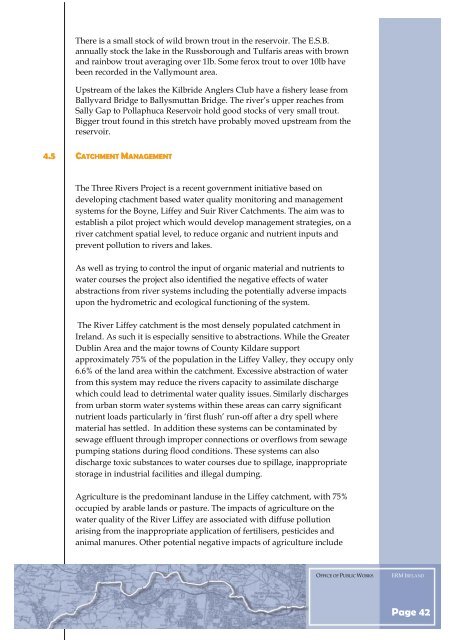Towards a Liffey Valley Strategy Doc. 1 - Kildare.ie
Towards a Liffey Valley Strategy Doc. 1 - Kildare.ie
Towards a Liffey Valley Strategy Doc. 1 - Kildare.ie
You also want an ePaper? Increase the reach of your titles
YUMPU automatically turns print PDFs into web optimized ePapers that Google loves.
There is a small stock of wild brown trout in the reservoir. The E.S.B.<br />
annually stock the lake in the Russborough and Tulfaris areas with brown<br />
and rainbow trout averaging over 1lb. Some ferox trout to over 10lb have<br />
been recorded in the Vallymount area.<br />
Upstream of the lakes the Kilbride Anglers Club have a fishery lease from<br />
Ballyvard Bridge to Ballysmuttan Bridge. The river’s upper reaches from<br />
Sally Gap to Pollaphuca Reservoir hold good stocks of very small trout.<br />
Bigger trout found in this stretch have probably moved upstream from the<br />
reservoir.<br />
4.5 CATCHMENT MANAGEMENT<br />
The Three Rivers Project is a recent government initiative based on<br />
developing ctachment based water quality monitoring and management<br />
systems for the Boyne, <strong>Liffey</strong> and Suir River Catchments. The aim was to<br />
establish a pilot project which would develop management strateg<strong>ie</strong>s, on a<br />
river catchment spatial level, to reduce organic and nutr<strong>ie</strong>nt inputs and<br />
prevent pollution to rivers and lakes.<br />
As well as trying to control the input of organic material and nutr<strong>ie</strong>nts to<br />
water courses the project also identif<strong>ie</strong>d the negative effects of water<br />
abstractions from river systems including the potentially adverse impacts<br />
upon the hydrometric and ecological functioning of the system.<br />
The River <strong>Liffey</strong> catchment is the most densely populated catchment in<br />
Ireland. As such it is especially sensitive to abstractions. While the Greater<br />
Dublin Area and the major towns of County <strong>Kildare</strong> support<br />
approximately 75% of the population in the <strong>Liffey</strong> <strong>Valley</strong>, they occupy only<br />
6.6% of the land area within the catchment. Excessive abstraction of water<br />
from this system may reduce the rivers capacity to assimilate discharge<br />
which could lead to detrimental water quality issues. Similarly discharges<br />
from urban storm water systems within these areas can carry significant<br />
nutr<strong>ie</strong>nt loads particularly in ‘first flush’ run-off after a dry spell where<br />
material has settled. In addition these systems can be contaminated by<br />
sewage effluent through improper connections or overflows from sewage<br />
pumping stations during flood conditions. These systems can also<br />
discharge toxic substances to water courses due to spillage, inappropriate<br />
storage in industrial facilit<strong>ie</strong>s and illegal dumping.<br />
Agriculture is the predominant landuse in the <strong>Liffey</strong> catchment, with 75%<br />
occup<strong>ie</strong>d by arable lands or pasture. The impacts of agriculture on the<br />
water quality of the River <strong>Liffey</strong> are associated with diffuse pollution<br />
arising from the inappropriate application of fertilisers, pesticides and<br />
animal manures. Other potential negative impacts of agriculture include<br />
OFFICE OF PUBLIC WORKS ERM IRELAND<br />
Page 42
















